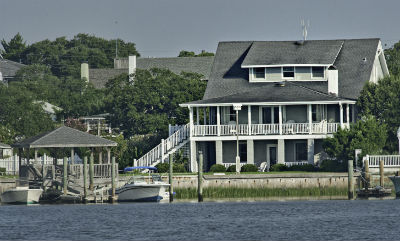WRIGHTSVILLE BEACH — Of its three regions, the N.C. Coastal Federation’s Southeast office has been the last to root its identity in a permanent building. This year the non-profit group’s patience may pay off in a fitting way. The federation proposes to transplant a donated historic beach cottage for reuse as the new regional office and Coastal Education Center for the Southeast, preserving a valuable piece of Wrightsville Beach history in the process.
“For the Coastal Federation to make that choice to move with historic preservation, to me, shows a commitment to the community,” said Madeline Flagler, director of the Wrightsville Beach Museum of History.
Supporter Spotlight
“If you don’t know where you are, you don’t know who you are,” she added, quoting poet and author Wendell Berry.
Wrightsville Beach was established in 1899 and has since survived many storms and other disasters, including a devastating fire in 1934. “The historic architecture here is really becoming endangered,” said Flager.
It’s what makes Wrightsville different from Morehead City or Isle of Palms, she said. “It’s what contributes to the uniqueness of your community,” she noted.
 The Palmgren-O’Quinn house will have to be moved by barge to its new location in the historic square in Wrightsville Beach. Photo: Ned Leary |
For the last couple years, the federation’s Southeast regional staff had thought of moving to a permanent location in the historic square of Wrightsville Beach, a property that was deeded to the town exclusively for non-profit organizations. This historic square at the center of the island, off West Salisbury Street, is the site of the Visitor Center and the history museum. To move into the historic square, the federation first had to find an historic home—not an easy task on an island little more than three-miles long. Everything seemed to fall into place last year when Debbie and Mark Mitchell, a local couple, donated their historic beach cottage to the federation.
The Mitchells were looking to build a new house in South Harbor Island where they’ve lived for many years, one that would accommodate old age with an elevator and space for their two children. “We wanted a house we could grow old in and we didn’t want to move,” said Debbie Mitchell, “so we bought the house next door.”
Supporter Spotlight
That house, known as The Palmgren-O’Quinn house, was built in 1946 and belonged to a former mayor of Wrightsville Beach, Robert O’Quinn. “It’s a very beautiful building with lots of wide open spaces, very typical of what you would expect to have at the beach,” commented Flagler.
The Mitchells planned to build a new house on the site. Rather than demolish the existing building, the couple decided to donate it, partially for sentimental reasons: “We loved the O’Quinns, and our kids have grown up playing in their yard. We certainly didn’t want to tear their house down,” Debbie said.
By word-of-mouth and a series of coincidences the federation was put in touch with the Mitchells, and in December the Wrightsville Beach Historic Landmark Commission approved the group’s request to move the Palmgren-O’Quinn house to the historic square. The request is scheduled to go before the Board of Alderman on Thursday to discuss the lease agreement.
“All the pieces of the puzzle are fitting together nicely even though we have a ways to go. We’re anticipating the move in May,” said Tracy Skrabal, project manager of the relocation and director of the federation’s Southeast office.
The historic house will not only be adaptively reused, but it will be creatively moved. “The only way to get it out intact is to take it by barge,” Skrabal said.
Currently the house sits in a neighborhood full of live oaks, leaving the water as the only viable exit strategy.
 Tracy Skrabal |
Not that the office minds the challenge. “The reason why we’re actually pleased with that is because part of our mission is preservation of cultural heritage, not just natural heritage,” said Skrabal.
The coast’s abundant natural resources have always shaped its history, she noted, and finding a regional office building that also preserved local history seemed like the perfect fit for the federation.
The proposed property on the historic square used to stockpile storm debris for the town of Wrightsville Beach. Now it will serve a greater purpose. “It’s not just a house and it’s not just a piece of dirt,” said Skrabal. “This land is going to be very close to the marshes and the sound so that we can use this area as a real public resource.”
Kids will be invited on marsh and estuary walks where they can pull up seine nets to learn about the marine life of their coastal ecosystem. Staff will also be able to teach the community hands-on about the relationship between land uses and ecosystems, as well as what can be done to lessen negative effects.
There will be demonstrations incorporating low-impact development techniques on the landscape with cisterns, rain gardens and permeable pavement. All help to alleviate the effects of stormwater pollution. The staff also wants to use native landscaping around the center and intends on building a plant nursery for growing marsh plants and other native vegetation. Ideas of importing oyster shells for bagging events are also being considered so that the office can build oyster reefs in local waters.
The regional office staff will no longer have to find rented or donated space to hold large meetings. In fact, they intend on hosting a wide range of educational meetings, speaker series and seminars on issues involving the coastal ecosystems, including topics of science, natural history and policy. The building will be personalized with permanent education displays and rotating art exhibits. And oyster roasts will no doubt be arranged, which can be fun occasions to learn about the work of the federation or membership and volunteer opportunities.
“It provides us with an identity in this region that we’ve been missing,” said Skrabal.
With a place to call home, the Coastal Education Center for the Southeast will be able to create memories with its community members while maximizing its role for coastal North Carolina, truly satisfying a sense of belonging.








